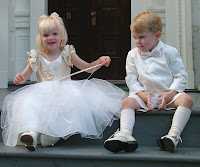 ide, groom and 2 witnesses standing up there before the Officiant the answer is “yes”, especially if there will be children as flower girls or ring bearers.
ide, groom and 2 witnesses standing up there before the Officiant the answer is “yes”, especially if there will be children as flower girls or ring bearers.If possible, hold the rehearsal only a day or 2 before the wedding so that it’s still fresh in everyone’s mind. You’ll have enough to do on your special day without adding in the rehearsal the morning of. On site is best, of course. But a similar setting will suffice in a pinch. If you are using an alternate site draw a diagram or floor plan of the actual setting and give a copy to all participants so they’ll have a mental image of the scene.
Who should attend? The bride, groom, their parents, grandparents, bridesmaids, groomsmen, (ushers) best man, best lady (maid or matron of honor) flower girls, ring bearers, Officiant and event planner. If there are children involved, have adult supervision for them both at the rehearsal and wedding in case the children need a quite place to rest.
First I’ll give you the traditional procession line-up and then current happenings.
The groom’s family and friends sit on the right. The bride’s on the left. Both front rows are saved for the parents and grandparents of the bride and groom.
Order of entrance after all guests have been seated is:
- Grandmothers and mothers are escorted by usher or groomsman.
- Grandmother of the groom – followed by grandfather
- Grandmother of the bride – followed by grandfather
- Mother of the groom – followed by groom’s father
- Mother of the bride
- Officiant, groom and best man (if no side access available)
- Bridesmaids escorted by groomsmen
- Flower girl(s) and ring bearer
- Best Lady (maid or matron of honor)
- Bride escorted by her father
That’s the traditional way but you could do it any way you like. It’s your wedding. If you’d like the girls to walk in single file then the groomsmen would stay in the front after they sat the grandmothers and mothers or enter from the side.
The bride could be escorted by the groom, her mother, step-father, brother, uncle, sister, grandmother, aunt or walk in alone. The bride could change partners part way down the aisle.
The Officiant could be escorted by the groom. The groom could escort his mother.
Some personal suggestions of my own:
Bride walks on the right of her escort and stops at the end of the front row of seats. As the groom steps forward to meet his bride, the father kisses the bride. The father shakes the groom’s hand and then steps to his left to sit. This way the father is free of the bride’s train. The groom offers his arm or hand to the bride and together they step forward to the Officiant.
When small children are involved they are usually more
 comfortable sitting rather than standing through out the whole procedure. Show them where they will sit and by whom they will sit. This will be the adult that is responsible for the care and comfort of the child.
comfortable sitting rather than standing through out the whole procedure. Show them where they will sit and by whom they will sit. This will be the adult that is responsible for the care and comfort of the child.Very young children could be walked in by a bridesmaid or the maid or matron of honor. I’ve been in weddings where the couple did not take this into consideration and a father or bystander carried the child down the aisle. Needless to say, the man was not prepared nor dressed for the occasion and it was very awkward.
If you don’t have a wedding or event planner, have someone who can help at the rehearsal and the day of the wedding who will signal each person when to walk, open doors for the bridal party (if applicable) and signal the processional music.
A few other miscellaneous items about “the walk”:
- Each person simply walks to the music rather than step-touch-step-touch. A natural step is more relaxed and less taxing.
- Flowers are carried at the waist/stomach area and not flopped down in front of “you know what”.
- The gentleman, who is escorting a lady, bends his proffered arm at the elbow and his forearm gently rests in front of his waist. That looks better than letting the arm dangle.
- And the last thing is – smile! If you look happy you’ll feel happy.



